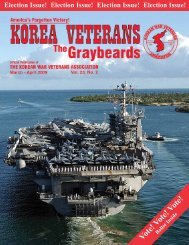The Graybeards - KWVA - Korean War Veterans Association
The Graybeards - KWVA - Korean War Veterans Association
The Graybeards - KWVA - Korean War Veterans Association
Create successful ePaper yourself
Turn your PDF publications into a flip-book with our unique Google optimized e-Paper software.
Back in the mid-1980s I read an article<br />
in a surveyor’s magazine called,<br />
“Surveying under Fire.” At the time I<br />
worked for a company called Wild<br />
Heerbrugg, Inc., based on Long Island,<br />
New York. I had been with the company<br />
for some seven years by then. My job at<br />
Wild was that of an equipment-systems<br />
trainer for dealer personnel selling the<br />
products and for end-users not familiar<br />
with Wild equipment.<br />
<strong>The</strong> article reminded me of a time thirty-plus<br />
years before when I surveyed under<br />
fire using similar Wild equipment. It<br />
reflected on the experience and times of<br />
surveying under fire in all the wars up to<br />
that time. <strong>The</strong> Army Topographic<br />
Engineers (Surveyors) made maps in the<br />
Revolutionary <strong>War</strong> for General<br />
Washington. Certainly once West Point got<br />
going academically in the early 1800s, the<br />
cadets had to have gotten some exposure to<br />
surveying and mapping techniques that<br />
would enhance their skills as engineers.<br />
Those skills would prove their worth on<br />
the fields of battle in their future assignments.<br />
But this author left out Korea. I thought,<br />
“Here is another writer who just skated<br />
right over us, again.” To understand and<br />
appreciate what units like the 8221st,<br />
Army Unit did in Korea is to look back at<br />
history through the larger end of the telescope.<br />
Fort Belvoir, Virginia served for many<br />
years as the home of the Army’s<br />
Topographic Engineers. Back in. the late<br />
1940’s and in the 1950’s the schools at<br />
Belvoir also turned out construction surveyors<br />
and related tradesmen for the Navy<br />
CB’s, the Marines and Army engineer battalions.<br />
At Fort Sill, Oklahoma, the home<br />
of the Field Artillery School of the Army,<br />
there was a school for artillery surveyors<br />
and related technical courses. Fort Sill was<br />
also the home of the 1st Observation<br />
Battalion, which included in its ranks surveyors,<br />
meteorological technicians, and<br />
range and flash people. Those folks were<br />
also schooled and trained at Fort Sill.<br />
Officers from West Point, OCS and ROTC<br />
programs were also schooled and trained at<br />
Sill to be Forward Observers and field<br />
artillery leaders. At Fort Bliss, Texas personnel<br />
transferred to the newly formed<br />
missile and rocket launching units were<br />
schooled and trained in special surveying<br />
<strong>The</strong> Combat<br />
Surveyor of<br />
Yesteryear<br />
By CW3 Michael C.J. Kaminski, USAR Ret.<br />
and related courses. Anyone in the military<br />
who came out of one of these schools with<br />
a certificate of completion or a diploma<br />
usually secured a good duty assignment<br />
with an established unit on location anywhere.<br />
<strong>The</strong> really good student graduates<br />
ended up at one of the school as an instructor.<br />
Fortunately—or unfortunately—I did<br />
not attend any school at Belvoir or at Bliss,<br />
but did graduate from the Artillery Survey<br />
School at Fort Sill in April of 1949, while<br />
a member of “A” Battery, 18th Field<br />
Artillery Battalion in 1948-49. I became a<br />
“Topo Man” (MOS 1230) through field<br />
experience with the 29th Topographic<br />
Engineers in the Philippines. My secondary<br />
MOS (1577) was that of an artillery<br />
surveyor. That all happened before the<br />
SFC Mike C.J. Kaminski with Wild T2 prepares<br />
for a Sun Azimuth Observation to<br />
check a line direction (1951).<br />
<strong>Korean</strong> <strong>War</strong> started in 1950.<br />
My other claim to fame as far as military<br />
experience is concerned is that I<br />
enlisted in 1947 in the old “Brown Shoe”<br />
Army with O.D. color boxer shorts for<br />
underwear with buttons, no fly zippers or<br />
Velcro on the trousers, the buttoned down<br />
Eisenhower jacket, the balloon pocket<br />
fatigue pants, the old style field jacket with<br />
buttons down the front and on the cuffs,<br />
and the two-buckle top leather combat<br />
boots. Oh! yeah and we had the helmet<br />
liner and piss-pot to protect our heads. It<br />
was used for everything from a latrine in<br />
an emergency to a wash basin in the field.<br />
We cooked in it, hammered in tent pegs<br />
with it, used it as a weapon on occasion,<br />
and even stashed our valuables in it. Yep,<br />
that is another whole story compared to the<br />
type of military clothing and equipment<br />
issued today.<br />
Speaking from experience, I know that<br />
architects dream and make plans.<br />
Engineers dream and build great works.<br />
Surveyors measure and just dream! All<br />
three of the career fields are intertwined<br />
along the way, and each profession has a<br />
working knowledge of the others. At Fort<br />
Belvoir and the other locations the training<br />
and instruction was chain-linked to related<br />
careers, i.e. computing, surveying, cartography,<br />
construction and engineering.<br />
However, like any school, military or civilian,<br />
once you got out and into reality, experience<br />
on the job is the best teacher.<br />
In Korea we all learned some reality<br />
lessons about our career field under<br />
adverse conditions. <strong>The</strong>re was a war on,<br />
not just training exercises. This was for<br />
Page 36<br />
<strong>The</strong> <strong>Graybeards</strong>
















